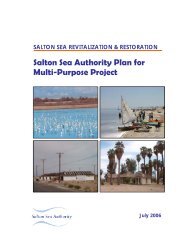Salton Sea Preliminary In-Sea Geotechnical Investigation
Salton Sea Preliminary In-Sea Geotechnical Investigation
Salton Sea Preliminary In-Sea Geotechnical Investigation
Create successful ePaper yourself
Turn your PDF publications into a flip-book with our unique Google optimized e-Paper software.
SECTIONTHREESite ConditionsSECTION 3SITE CONDITIONSKnowledge of the site conditions has been developed from a review of the area geology, the previousinvestigations within the <strong>Sea</strong>, the bathymetry and topography that was available, and the field andlaboratory programs undertaken for this preliminary geotechnical investigation.3.1 GEOLOGIC SETTINGThe <strong>Salton</strong> <strong>Sea</strong> currently occupies the lowest portion of the <strong>Salton</strong> Trough, a deep basin that representsthe structural extension of the Gulf of California into North America. The Trough is essentially a closedbasin, bounded by mountains within the Western Mojave Desert Province to the north, the Basin andRange Province to the east, and the Peninsular Range Batholith to the west. To the south, deltaic depositsof the Colorado River prevent marine inundation from the Gulf of California. A geologic map presentingthe surficial geology of the area surrounding the <strong>Sea</strong> is presented in Figure 6; a legend for the geologicmap is presented in Figure 7.3.1.1 StructureThe <strong>Salton</strong> Trough is a deep structural pull-apart basin characterized by high seismicity, high geothermalactivity, extensional tectonics, crustal thinning, and rapid sedimentation (Damiata et. al., 1986). The basinis bounded by major, northwest trending, strike slip faults and uplifted highlands of crystalline rock.Geophysical studies (Tarbet, 1951; Biehler et. al., 1964) suggest that upwards of 18,000 feet (3.4-miles)of sediment have accumulated in the <strong>Salton</strong> Trough since the Miocene epoch (Eberley and Standley,1978). The central portion of the valley is underlain by a 6 to 10-mile deep trough of sedimentary andmetasedimentary rocks (Fuis et. al., 1982).3.1.2 StratigraphyThe <strong>Salton</strong> Trough is a deep basin that has been filling with sediments since the Miocene epoch. Theoldest, basal sediments, are the coarse clastic materials of the Anza Formation that where shed off thesurrounding crystalline highlands. The Anza Formation outcrops at the surface along the margins of thebasin. Within the southern portion of the basin, the Anza Formation interfingers and is overlain by asequence of essentially continuous deposits including the Alverson volcanics, playa deposits of the FishCreek Gypsum, marine and non-marine sediments of the Split Mountain Formation, marine deposits ofthe Imperial Formation, terrestrial deposits of the Palm Springs Formation, the Canebrake Conglomerate,and the subsequent alluvial and terrace deposits of Quaternary age. The most recent deposits within thecentral portion of the Trough are dominated by lacustrine, deltaic, and fluvial deposition associated withHolocene and Pleistocene stands of ancient Lake Cahuilla.Around the margins of the <strong>Salton</strong> Trough basin, relict shoreline features mark the former high stands ofancient Lake Cahuilla. The ancient lake repeatedly filled and occupied the basin during the Holocene. Themost recent, pre-<strong>Salton</strong> <strong>Sea</strong> filling is thought to have occurred about 1,650 years ago (Norris and others,1979). The lake may have been in existence as recently a several hundred years ago (Morton, 1977). Sandand gravel deposits along the ancient shoreline have been locally mined for aggregate. Travertine depositsdelineate ancient lake levels above the west side of the <strong>Sea</strong>.W:\27663042\00005-c-r.doc\1-Mar-04\SDG 3-1



